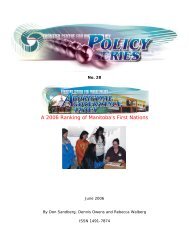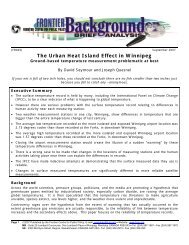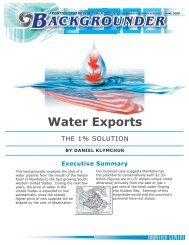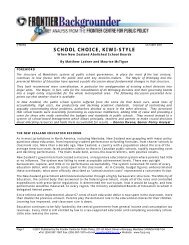The New Paradigm - Federal Reserve Bank of Dallas
Create successful ePaper yourself
Turn your PDF publications into a flip-book with our unique Google optimized e-Paper software.
40<br />
3. SIGNIFICANT ACCOUNTING POLICIES<br />
Accounting principles for entities with the unique powers and responsibilities <strong>of</strong> the<br />
nation’s central bank have not been formulated by the Financial Accounting Standards<br />
Board. <strong>The</strong> Board <strong>of</strong> Governors has developed specialized accounting principles and<br />
practices that it believes are appropriate for the significantly different nature and function<br />
<strong>of</strong> a central bank as compared with the private sector. <strong>The</strong>se accounting principles<br />
and practices are documented in the “Financial Accounting Manual for <strong>Federal</strong> <strong>Reserve</strong><br />
<strong>Bank</strong>s” (“Financial Accounting Manual”), which is issued by the Board <strong>of</strong> Governors. All<br />
<strong>Reserve</strong> <strong>Bank</strong>s are required to adopt and apply accounting policies and practices that<br />
are consistent with the Financial Accounting Manual.<br />
<strong>The</strong> financial statements have been prepared in accordance with the Financial Accounting<br />
Manual. Differences exist between the accounting principles and practices <strong>of</strong> the System<br />
and generally accepted accounting principles (“GAAP”) in the United States. <strong>The</strong> primary<br />
differences are the presentation <strong>of</strong> all security holdings at amortized cost rather<br />
than at the fair value presentation requirements <strong>of</strong> GAAP, and the accounting for<br />
matched sale–purchase transactions as separate sales and purchases rather than<br />
secured borrowings with pledged collateral, as is required by GAAP. In addition, the <strong>Bank</strong><br />
has elected not to include a Statement <strong>of</strong> Cash Flows or a Statement <strong>of</strong> Comprehensive<br />
Income. <strong>The</strong> Statement <strong>of</strong> Cash Flows has not been included, as the liquidity and cash<br />
position <strong>of</strong> the <strong>Bank</strong> are not <strong>of</strong> primary concern to users <strong>of</strong> these financial statements.<br />
<strong>The</strong> Statement <strong>of</strong> Comprehensive Income, which comprises net income plus or minus<br />
certain adjustments, such as the fair value adjustment for securities, has not been<br />
included because, as stated above, the securities are recorded at amortized cost and<br />
there are no other adjustments in the determination <strong>of</strong> Comprehensive Income applicable<br />
to the <strong>Bank</strong>. Other information regarding the <strong>Bank</strong>’s activities is provided in, or<br />
may be derived from, the Statements <strong>of</strong> Condition, Income, and Changes in Capital.<br />
<strong>The</strong>refore, a Statement <strong>of</strong> Cash Flows or a Statement <strong>of</strong> Comprehensive Income would<br />
not provide any additional useful information. <strong>The</strong>re are no other significant differences<br />
between the policies outlined in the Financial Accounting Manual and GAAP.<br />
<strong>The</strong> preparation <strong>of</strong> the financial statements in conformity with the Financial Accounting<br />
Manual requires management to make certain estimates and assumptions that<br />
affect the reported amounts <strong>of</strong> assets and liabilities and disclosure <strong>of</strong> contingent assets<br />
and liabilities at the date <strong>of</strong> the financial statements and the reported amounts <strong>of</strong><br />
income and expenses during the reporting period. Actual results could differ from those<br />
estimates. Unique accounts and significant accounting policies are explained below.<br />
a. Gold Certificates<br />
<strong>The</strong> Secretary <strong>of</strong> the Treasury is authorized to issue gold certificates to the <strong>Reserve</strong><br />
<strong>Bank</strong>s to monetize gold held by the U.S. Treasury. Payment for the gold certificates by<br />
the <strong>Reserve</strong> <strong>Bank</strong>s is made by crediting equivalent amounts in dollars into the account<br />
established for the U.S. Treasury. <strong>The</strong>se gold certificates held by the <strong>Reserve</strong> <strong>Bank</strong>s are<br />
required to be backed by the gold <strong>of</strong> the U.S. Treasury. <strong>The</strong> U.S. Treasury may reacquire<br />
the gold certificates at any time, and the <strong>Reserve</strong> <strong>Bank</strong>s must deliver them to the U.S.<br />
Treasury. At such time, the U.S. Treasury’s account is charged and the <strong>Reserve</strong> <strong>Bank</strong>s’<br />
gold certificate accounts are lowered. <strong>The</strong> value <strong>of</strong> gold for purposes <strong>of</strong> backing the gold<br />
certificates is set by law at $42-2/9 a fine troy ounce. <strong>The</strong> Board <strong>of</strong> Governors allocates<br />
the gold certificates among <strong>Reserve</strong> <strong>Bank</strong>s once a year based upon <strong>Federal</strong> <strong>Reserve</strong><br />
notes outstanding in each District at the end <strong>of</strong> the preceding year.<br />
1999 ANNUAL REPORT <strong>Federal</strong> <strong>Reserve</strong> <strong>Bank</strong> <strong>of</strong> <strong>Dallas</strong>

















